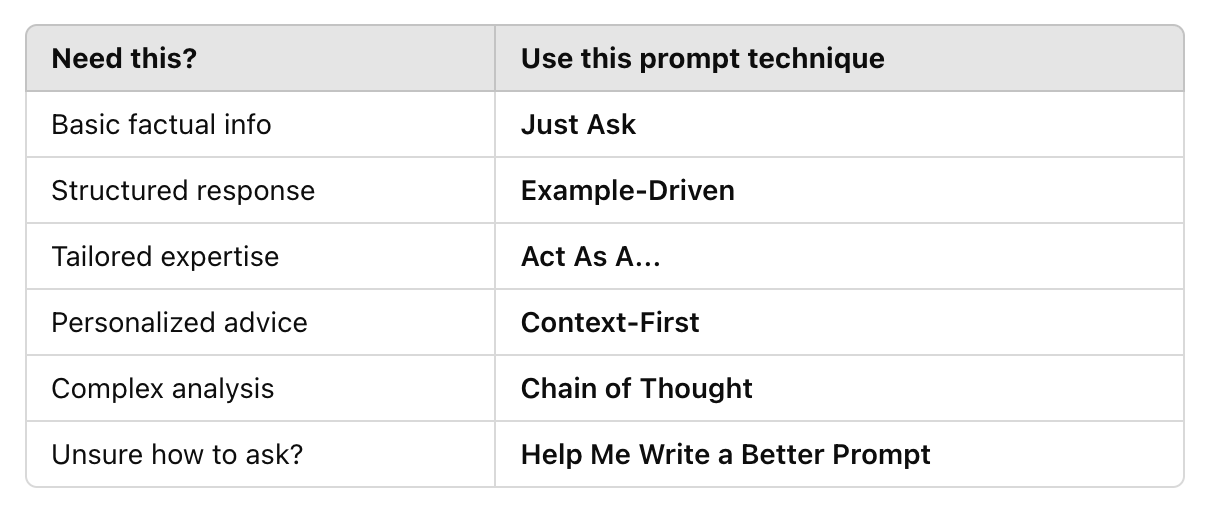Beyond “Just Ask”: A Guide to Smarter AI Conversations for Parents & Learners
Six prompting techniques to help AI deliver clearer, deeper, and more useful responses—with the help of the southern right whales.

The secret to using AI well? It all starts with the prompt.
ChatGPT, Claude, and other AI tools can generate insights that make you go "whaaaat?!"—or just serve up a bland, "meh" response. The difference? How you ask the question.
The techy kids call this prompt engineering, but don’t let the fancy terminology scare you off. We can all be prompt engineers when it comes to education and lifelong learning—and it doesn’t have to be complicated.
In this post, Garren1 will walk you through six simple but powerful prompts that work in different situations—starting with the easiest and building up to more advanced techniques. To illustrate how different prompting techniques work, we'll use the example of southern right whales—using each method to uncover different aspects of these magnificent marine mammals.
If you want to see the full AI responses and compare how each technique shapes them, you can check out Shelley’s full Claude chat here. In this chat, Shelley ran Garren’s prompts to test them out.
Let’s dive in. Or rather, let’s breach and splash! 🐋
1. The Just Ask Prompt: Simplicity With Purpose
The most straightforward approach is simply asking a direct question:
What are southern right whales?
This works well for basic information but can yield overwhelming results. Instead, refining the scope helps:
What are the three most distinctive physical characteristics of southern right whales?
This version provides clear parameters. Claude summarized:
Callosities - Rough patches of skin on their heads, unique to each whale.
Lack of dorsal fin - A smooth back makes them easy to identify.
V-shaped blow - Their spout is a distinctive identifier.
This method is great for quick, factual answers—just be as specific as possible.
Oh, and part of being specific is specifying your required answer length. Ask the AI to be brief or concise to prevent the common malady of information overload!
2. The Example-Driven Prompt: Showing The Pattern
Sometimes, you want information presented in a structured way. Example-driven prompts provide a template:
I want information about different whale species formatted into a table. Use the following two examples to present the information and then provide the same kind of data for the following species: Sperm Whale, Humpback Whale, and Southern Right Whale:
Example 1:
SPECIES: Blue Whale (Balaenoptera musculus)
CATEGORY: Baleen whale (Mysticeti)
SIZE RANGE: 80-100 feet
DIET: Primarily krill
DISTINCTIVE FEATURES: Blue-gray coloration, incredibly long body, relatively small dorsal fin
CONSERVATION STATUS: EndangeredExample 2:
SPECIES: Orca (Orcinus orca)
CATEGORY: Toothed whale (Odontoceti)
SIZE RANGE: 20-26 feet
DIET: Fish, seals, other marine mammals
DISTINCTIVE FEATURES: Black and white coloration, large dorsal fin
CONSERVATION STATUS: Data deficient (some populations endangered)*
Using examples clarifies expectations, ensuring AI delivers responses in the desired format.
And remember, this kind of prompt is not just for dry facts. You can get your AI to give you more quirky, metaphorical facts too. Here's an example:
Please summarize whale species in the style of a children’s nature guide. Each summary should follow this format:
Whale Name: [Common name]
Size: [How big it gets]
What It Eats: [Diet in simple terms]
Cool Fact: [A fun or surprising fact kids would love]
Where It Lives: [Habitat description]
Here’s an example:
🐋 Whale Name: Southern Right Whale
📏 Size: As long as a city bus! (Up to 16 meters)
🍽 What It Eats: Tiny ocean creatures like krill and copepods.
🤯 Cool Fact: Southern right whales have big, bumpy patches on their heads called callosities—and each whale has a unique pattern, like a fingerprint!
🌊 Where It Lives: Cold waters near coasts, especially in the Southern Hemisphere.
Now, please provide the same kind of summary for a Sperm Whale, Humpback Whale, and Narwhal.
Adding some style in this way leads us neatly on to our next prompting technique.
3. The "Act As A..." Prompt: Perspective Shift
This technique tailors AI responses to a particular voice or expertise level:
Act as a marine biologist explaining southern right whale migration to 10-13 year-olds.
Claude responded with a personality-driven breakdown, describing the whales’ seasonal movements, feeding grounds, and why they return to the same places year after year.
However, I have to admit, I found the tone of Claude’s response a little too simplified—almost condescending. (Come on, 10-year-olds know the term "pregnant"!)
So remember, it’s worth tweaking the AI’s tone in follow-up prompts if the response isn’t quite right. We'll be writing more about prompt refinement in future posts.
Other variations:
Act as a whale-watching tour guide describing what we’re seeing.
Act as a historical naturalist documenting these creatures.
4. The Context-First Prompt: Background Before Questions
Providing background details before your question helps AI generate personalized answers:
CONTEXT: I'm planning a whale-watching trip to Hermanus, South Africa next August with my family. We're interested in seeing southern right whales and learning about their behaviors. We'll be staying for three days and can schedule our whale-watching excursion on any of those days.
QUESTION: What's the best time of day to go, what behaviors might we observe, and how can we maximize our chances of a good sighting?
Claude started by telling me that we'd chosen a great time of year to visit. It gave the tip to book our whale-watching excursion for our first day, so we could postpone in the case of inclement weather. Knowing we were going to Hermanus, it also recommended a walk along the Cliff Path as an alternative to a boat tour—not a bad suggestion, given my low tolerance for boat travel!
So, the more details you provide upfront, the more customized your results become. But don't go overboard with detail—this could have the effect of confusing the AI and limiting the possibilities it could offer.
5. The Chain of Thought Prompt: Transparency in Reasoning
For complex topics, asking AI to show its reasoning step-by-step results in more thorough responses:
Analyze step-by-step the conservation status of southern right whales, considering historical population, current threats, and recovery efforts.
Claude outlined:
Historical Decline - Whaling reduced numbers by 95%.
Protection Measures - International bans since 1935.
Recovery Trends - Some populations growing 7-8% annually.
Current Threats - Ship strikes, entanglement, climate change.
Future Outlook - Population still below pre-whaling levels but improving.
Other phrases you could use to start a prompt like this are: "reason through this" or "walk through your thinking" to encourage detailed explanation of the reasoning process.
What I love about this approach is that it gives me more to work with. Instead of just taking AI’s word for it, I can analyze each step and determine whether I agree with its reasoning.
A major criticism of AI is that it can potentially be inaccurate and biased. Chain of thought prompting is one way that we can mitigate against that. I believe that this is one of the skills we’re going to need to teach our kids, as AI becomes more of a fixture in education.
6. The "Help Me Write a Better Prompt" Approach: Collaborative Refinement
When unsure how to phrase a request, let AI assist:
I want to learn about southern right whale conservation. What would be an effective, detailed prompt to get the best response?
Claude suggested refining the prompt by:
Specifying exact details (species, region, historical context, current status).
Breaking it down into clear categories (e.g., threats, conservation methods, scientific research).
Requesting region-specific information to compare conservation efforts across different locations.
Asking for specific examples and case studies to avoid vague generalizations.
Encouraging discussion of debates and controversies in conservation strategies.
By refining the prompt, AI-generated responses become more targeted, nuanced, and informative.
This method is great for when you’re hitting a dead-end with AI and feel like you’re not getting the depth you need.
Hey, it takes one to know one, so why not use AI to up its own game?!
Choosing The Right Approach
Here’s a summary:
Embracing Experimentation
AI prompting is a skill—one that values clarity but rewards creativity. In many ways, you're learning a new language. Play around with different techniques, tweak responses, and refine your approach over time. Some of the best AI interactions happen through curiosity and iteration.
Here are some other AI Diaries Posts you might enjoy and draw some inspiration from:
Let us know in the comments if you use any of these prompting techniques and what infinitely interesting insights you uncover.
Want more AI-powered learning ideas?
Like this post (click the heart below 🤍) and subscribe to the AI Diaries on Infinitely Interesting and follow along as we experiment, explore, and learn together!
Subscribing to this Substack is completely free of charge2, but if you’d like to spread the love, we’d love it if you shared it with a friend.
We really do need to write a proper “About Us” post. In the meantime, “Hi, we’re Shelley and Garren. We’re married with two musical, karate-chopping, wall-climbing children— whom we homeschool. Garren is a software developer who’s recently been diving into the world of AI prompt engineering—hence his enthusiasm to write this post. Shelley is a copywriter-turned-edupreneur and Learning in Depth mentor—hence her enthusiasm to (over?) edit, test, and publish this post.”
Stage whisper: it’s unlikely we’ll ever offer a paid newsletter, because Stripe (the only payment processor Substack offers) is not available in South Africa. So if you’d like to support our work, the best (and most highly appreciated) thing you can do right now is to like and share this post with your friends. :)









This is brilliant. I immediately saved this to Readwise. It was such a great idea to include both the techniques and when they are likely to be most useful. I will definitely refer to this post when thinking about prompting in the future.
6.0!